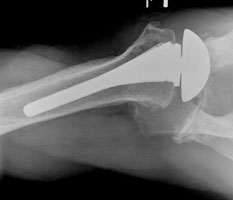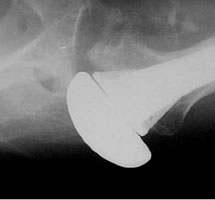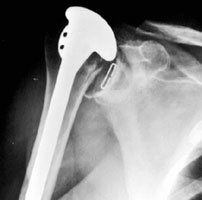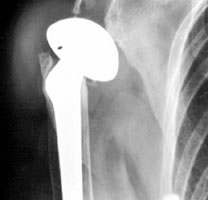Implant positioning, soft tissue balancing can help avoid post-TSA instability
Cases of acute posterior instability should be diagnosed immediately and confirmed with imaging.
Although instability represents nearly a third of all complications after total shoulder arthroplasty, the problem is avoidable, Robert H. Bell, MD, said.
“The cause of instability after total shoulder is usually multifactorial,” Bell said during his presentation at the 10th Annual Current Concepts in Joint Replacement Spring 2009 Meeting. “Avoidance requires careful component positioning, attention to the soft tissue sleeve and intraoperative stability assessment. If you sense instability intraoperatively, address it. If you are worried postoperatively, diagnose it and treat it immediately.”
Anterior instability
The most common direction of instability following shoulder arthroplasty is anterior and often has as its etiology subscapularis deficiency or failure, he told Orthopedics Today. Contributing factors to anterior instability can be component malposition, undersized modular heads, glenoid deficiency and undersized glenoid components. Patients with anterior instability will note a sudden increase in external rotation and physical exam will manifest positive findings on maneuvers of subscapularis testing. Early recognition is the key to treatment and the subscapularis should be assessed via subtraction MRI or ultrasound and the humeral component must be assessed radiographically to rule out excessive anteversion.
“If this is diagnosed in the first 4 weeks, I recommend a primary repair of the subscapularis,” Bell said. “You should be prepared to use a pectoralis transfer and if need be, augment with Achilles tendon allograft.”
Posterior instability
He noted that posterior instability accounts for 20% of instability problems. The etiology and treatment of posterior instability can be multifactorial.
“If you have an acute posterior instability event, you need to diagnose it immediately,” Bell said. Patients with this form of instability will show a sudden decrease in external rotation, and the diagnosis may be confirmed with an axillary view.
“My preference is to reduce these with a general anesthetic, so I can do a concomitant exam under anesthesia, and then I immobilize them with an external rotation brace for 3 weeks,” Bell said. “However, be aware of the fact that these often will be recurrent due to other component issues that you have not yet diagnosed. The exam under anesthesia allows for both an assessment of the soft tissue construct of the shoulder while also evaluating the dynamics of the joint using imaging. A healthy level of suspicion preoperatively is warranted in these difficult cases.”
Bell said that many patients with osteoarthritis will have moderate posterior subluxation of the humeral head on the glenoid, resulting in not only eccentric and uneven glenoid wear, but posterior capsular laxity.
“This laxity must be noted intraoperatively and, if excessive, addressed with plication and component modification,” he said. “Of course, soft tissue balancing is critical in all shoulder arthroplasty and requires releases and lengthening of the anterior capsule and subscapularis along with attention to the posterior capsule.”
|
|
|
|
|
Images: Bell RH |
Superior instability
Up to 30% all total shoulder arthroplasties (TSAs) will have some degree of associated cuff deficiency which can cause superior migration of the humeral head towards the inferior acromion. This superior displacement results in eccentric loading of the glenoid and a resultant increase in glenoid loosening, he said. “It is best to recognize the at-risk shoulder preoperatively and obtain MRI imaging to assess the rotator cuff tissue. If a repairable effect is encountered, standard arthroplasty is performed with concomitant cuff repair. If the rotator cuff tissue is deemed irreparable, a glenoid component should not be implanted for fear of early failure. Alternative treatments such as hemiarthroplasty, resurfacing and reverse arthroplasty should be considered.”
Inferior instability
Bell cited incorrect humeral height as the most common cause of inferior instability. An avoidable complication seen most commonly in fracture cases requiring hemiarthroplasty, inferior instability is due to improper component positioning. Appropriate templating preoperatively of the unaffected humerus and intraoperative films will minimize this problem and assure optimal component position. Axillary neurapraxia can also result in an inferiorly subluxed humeral component. Recognition of an axillary nerve injury preoperatively is important and avoidance of traction intraoperatively will mitigate this risk, he said.
For more information:
- Robert H. Bell, MD, can be reached at the Crystal Clinic, 3975 Embassy Pkwy Ste. 102, Akron, OH 44333; 330-668-4040; e-mail: roberthbell@aol.com. He has independent consulting, teaching, speaking, and intellectual property rights arrangements with Stryker.
Reference:
- Bell RH. Instability following arthroplasty: A question of balance. Paper #14. Presented at the 10th Annual Current Concepts in Joint Replacement Spring Meeting. May 17-20, 2009. Las Vegas, NV.




